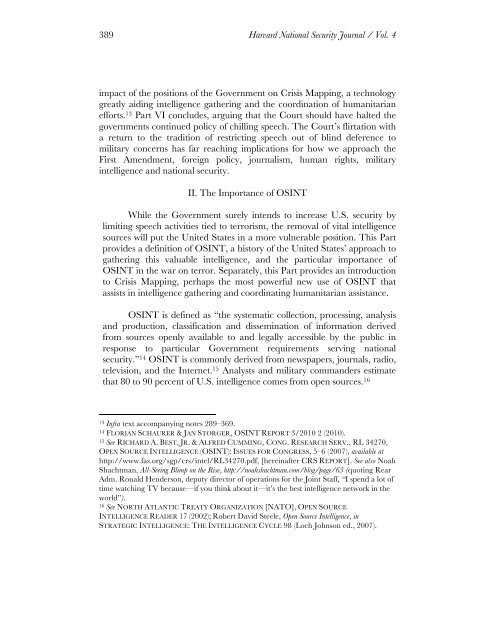Vo.4-Moshirnia-Final
Vo.4-Moshirnia-Final
Vo.4-Moshirnia-Final
You also want an ePaper? Increase the reach of your titles
YUMPU automatically turns print PDFs into web optimized ePapers that Google loves.
389 Harvard National Security Journal / Vol. 4<br />
impact of the positions of the Government on Crisis Mapping, a technology<br />
greatly aiding intelligence gathering and the coordination of humanitarian<br />
efforts. 13 Part VI concludes, arguing that the Court should have halted the<br />
governments continued policy of chilling speech. The Court’s flirtation with<br />
a return to the tradition of restricting speech out of blind deference to<br />
military concerns has far reaching implications for how we approach the<br />
First Amendment, foreign policy, journalism, human rights, military<br />
intelligence and national security.<br />
II. The Importance of OSINT<br />
While the Government surely intends to increase U.S. security by<br />
limiting speech activities tied to terrorism, the removal of vital intelligence<br />
sources will put the United States in a more vulnerable position. This Part<br />
provides a definition of OSINT, a history of the United States’ approach to<br />
gathering this valuable intelligence, and the particular importance of<br />
OSINT in the war on terror. Separately, this Part provides an introduction<br />
to Crisis Mapping, perhaps the most powerful new use of OSINT that<br />
assists in intelligence gathering and coordinating humanitarian assistance.<br />
OSINT is defined as “the systematic collection, processing, analysis<br />
and production, classification and dissemination of information derived<br />
from sources openly available to and legally accessible by the public in<br />
response to particular Government requirements serving national<br />
security.” 14 OSINT is commonly derived from newspapers, journals, radio,<br />
television, and the Internet. 15 Analysts and military commanders estimate<br />
that 80 to 90 percent of U.S. intelligence comes from open sources. 16<br />
13 Infra text accompanying notes 289–369.<br />
14 FLORIAN SCHAURER & JAN STORGER, OSINT REPORT 3/2010 2 (2010).<br />
15 See RICHARD A. BEST, JR. & ALFRED CUMMING, CONG. RESEARCH SERV., RL 34270,<br />
OPEN SOURCE INTELLIGENCE (OSINT): ISSUES FOR CONGRESS, 5–6 (2007), available at<br />
http://www.fas.org/sgp/crs/intel/RL34270.pdf, [hereinafter CRS REPORT]. See also Noah<br />
Shachtman, All-Seeing Blimp on the Rise, http://noahshachtman.com/blog/page/63 (quoting Rear<br />
Adm. Ronald Henderson, deputy director of operations for the Joint Staff, “I spend a lot of<br />
time watching TV because—if you think about it—it’s the best intelligence network in the<br />
world”).<br />
16 See NORTH ATLANTIC TREATY ORGANIZATION [NATO], OPEN SOURCE<br />
INTELLIGENCE READER 17 (2002); Robert David Steele, Open Source Intelligence, in<br />
STRATEGIC INTELLIGENCE: THE INTELLIGENCE CYCLE 98 (Loch Johnson ed., 2007).
















